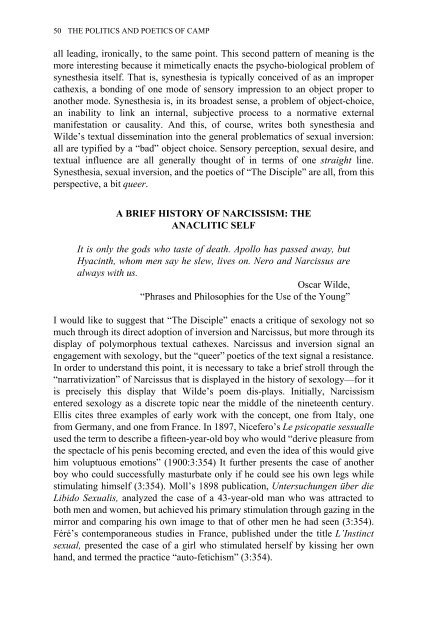Edited by Moe Meyer - Get a Free Blog
Edited by Moe Meyer - Get a Free Blog
Edited by Moe Meyer - Get a Free Blog
Create successful ePaper yourself
Turn your PDF publications into a flip-book with our unique Google optimized e-Paper software.
50 THE POLITICS AND POETICS OF CAMP<br />
all leading, ironically, to the same point. This second pattern of meaning is the<br />
more interesting because it mimetically enacts the psycho-biological problem of<br />
synesthesia itself. That is, synesthesia is typically conceived of as an improper<br />
cathexis, a bonding of one mode of sensory impression to an object proper to<br />
another mode. Synesthesia is, in its broadest sense, a problem of object-choice,<br />
an inability to link an internal, subjective process to a normative external<br />
manifestation or causality. And this, of course, writes both synesthesia and<br />
Wilde’s textual dissemination into the general problematics of sexual inversion:<br />
all are typified <strong>by</strong> a “bad” object choice. Sensory perception, sexual desire, and<br />
textual influence are all generally thought of in terms of one straight line.<br />
Synesthesia, sexual inversion, and the poetics of “The Disciple” are all, from this<br />
perspective, a bit queer.<br />
A BRIEF HISTORY OF NARCISSISM: THE<br />
ANACLITIC SELF<br />
It is only the gods who taste of death. Apollo has passed away, but<br />
Hyacinth, whom men say he slew, lives on. Nero and Narcissus are<br />
always with us.<br />
Oscar Wilde,<br />
“Phrases and Philosophies for the Use of the Young”<br />
I would like to suggest that “The Disciple” enacts a critique of sexology not so<br />
much through its direct adoption of inversion and Narcissus, but more through its<br />
display of polymorphous textual cathexes. Narcissus and inversion signal an<br />
engagement with sexology, but the “queer” poetics of the text signal a resistance.<br />
In order to understand this point, it is necessary to take a brief stroll through the<br />
“narrativization” of Narcissus that is displayed in the history of sexology—for it<br />
is precisely this display that Wilde’s poem dis-plays. Initially, Narcissism<br />
entered sexology as a discrete topic near the middle of the nineteenth century.<br />
Ellis cites three examples of early work with the concept, one from Italy, one<br />
from Germany, and one from France. In 1897, Nicefero’s Le psicopatie sessualle<br />
used the term to describe a fifteen-year-old boy who would “derive pleasure from<br />
the spectacle of his penis becoming erected, and even the idea of this would give<br />
him voluptuous emotions” (1900:3:354) It further presents the case of another<br />
boy who could successfully masturbate only if he could see his own legs while<br />
stimulating himself (3:354). Moll’s 1898 publication, Untersuchungen über die<br />
Libido Sexualis, analyzed the case of a 43-year-old man who was attracted to<br />
both men and women, but achieved his primary stimulation through gazing in the<br />
mirror and comparing his own image to that of other men he had seen (3:354).<br />
Féré’s contemporaneous studies in France, published under the title L’Instinct<br />
sexual, presented the case of a girl who stimulated herself <strong>by</strong> kissing her own<br />
hand, and termed the practice “auto-fetichism” (3:354).


